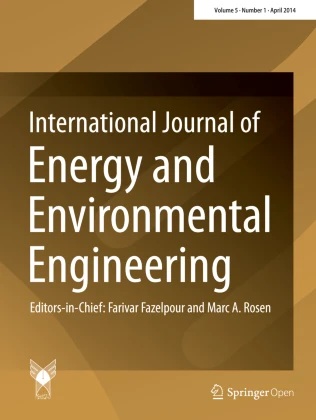Experimental testing of the heating performance of a rotor-type dissipative liquid heater
- Department of Energy Technologies, Cherkasy State Technological University, Cherkasy, 18006, UA

Published in Issue 2020-08-03
How to Cite
Bespalko, S., Halychyi, O., Yovchenko, A., Plakhotnyi, O., Poliakov, S., Kaleinikov, G., Roha, M., & Fenko, I. (2020). Experimental testing of the heating performance of a rotor-type dissipative liquid heater. International Journal of Energy and Environmental Engineering, 12(1 (March 2021). https://doi.org/10.1007/s40095-020-00354-0
Abstract
Abstract The study focuses on the development of technology for volumetric noncontact liquid heating based on the dissipative liquid heating effect and realized in a high-gradient flow in the rotor–stator system of a hydrodynamic apparatus. In this paper, the heating performance of a prototype of a rotor-type dissipative liquid heater is studied, and the dynamics of several parameters, such as the heat power generated, the electrical power consumed and the efficiency factor, are defined. It is shown that the time evolution of the efficiency factor along with the other parameters displays a nonlinear character and depends on the flow pattern of the water–vapor system. It is found that the highest efficiency of the dissipative liquid heating of 91.6% is observed in the froth flow of the two-phase water–vapor system. In addition, potential industrial applications of the dissipative liquid heaters are discussed.References
- Schlichting, H., Gersten, K.: Boundary-Layer Theory, 9th ed. Springer, Berlin (2017). 10.1007/978-3-662-52919-5
- Wikipedia: Mechanical Equivalent of Heat.
- https://en.wikipedia.org/wiki/Mechanical_equivalent_of_heat
- . Accessed 23 June 2020.
- Breido et al. (2017) Methods of studying electric-hydrodynamic heater (pp. 59-65) https://doi.org/10.1016/j.egypro.2017.09.015
- An alternative to gas boilers: hydrodynamic heater.
- https://tekmash.org/catalog/goods/95
- . Accessed 23 June 2020.
- Hydrodynamic heat generators.
- https://ctsystems.ua/?page_id=16
- . Accessed 23 June 2020.
- Kwon and Yoon (2012) Experimental study of a cavitation heat generator (pp. 67-73) https://doi.org/10.1177/0954408912451535
- Song and Kang (2016) Heating performance of a heating unit using hydrodynamic cavitation (pp. 203-211) https://doi.org/10.14397/jals.2016.50.4.203
- Pyun, K.B., Kwon, W.C., Oh, K.T., Yoon, J.Y.: Investigation of the performance for a heat generator using hydrodynamic cavitation. In: Proceedings of the ASME-JSME-KSME 2011 Joint Fluids Engineering Conference AJK-Fluids 2011 July 24–29, 2011, Hamamatsu, Shizuoka, JAPAN. Paper No. AJK2011-22045, pp. 701–706.
- https://doi.org/10.1115/AJK2011-22045
- Nikolsky et al. (2017) Examining a cavitation heat generator and the control method over the efficiency of its operation (pp. 22-28) https://doi.org/10.1558/1729-4061.2017.108580
- Dyussenov et al. (2013) The using of controlled cavitation processes in some engineering and agricultural applications (pp. 89-94) https://doi.org/10.13189/ujes.2013.010304
- Sun et al. (2018) An experimental study on the thermal performance of a novel hydrodynamic cavitation reactor (pp. 200-210) https://doi.org/10.1016/j.expthermflusci.2018.02.034
- Tahmid, S.M., Gill, B.S., Park, K.M., Ryu, Y., Lee, S.: Optimization and testing of a first generation cavitation heat pump. In: Proceeding of the 120th ASEE Annual Conference & Exposition 2013, Atlanta. Paper ID #6649.
- US 2005/0051 111A1 Apparatus and method of heating fluids (Christian Helmut Thoma) 10 March 2005.
- https://patents.google.com/patent/US20050051111A1/en
- . Accessed 23 June 2020
- WO 2008/108596 A1 Method for generating high temperature using cavitation and apparatus thereof (Gun Kie Jung) 12 September 2008.
- https://patents.google.com/patent/WO2008108596A1/und
- . Accessed 23 June 2020
- Bespalko, S.A.: The Dissipative Heating of Liquid in the Closed Loop System with the Hydrodynamic Heat-Generator. PhD thesis, National Technical University of Ukraine “Kyiv Polytechnic Institute”, Kyiv (2008)
- (in Ukrainian)
- Promtov (2001) Mashinostroenie 1
- Khalatov (2005) National Academy of Sciences of Ukraine Institute of Engineering Thermophysics
- Moon, H.-K., O'Konnel, T., Glezer, B.: Channel Height Effect on Heat Transfer and Friction in a Dimpled Passage. ASME. 1999. Paper no 99-GT-163.
- Moon, S.W., Lau S.C.: Turbulent heat transfer measurements on a wall with concave and cylindrical dimples in a square channel. In: Proceedings of ASME Turbo Expo-48, June 2002, № GT2002–30208, Amsterdam, the Netherlands, pp. 1–9.
- Kubanskiy (1957) Behavior of resonance system in turbulent flow 27(1) (pp. 180-188)
- Dolynskyi et al. (1996) ITTP of the National Academy of Sciences of Ukraine
- Monteith and Unsworth (2008) AP
- Taylor (1923) Stability of a viscous liquid contained between two rotating cylinders (pp. 289-293) https://doi.org/10.1098/rsta.1923.0008
- Becker and Kaye (1962) Measurements of diabatic flow in an annulus with an inner rotating cylinder (pp. 97-104) https://doi.org/10.1115/1.3684335
- Kaye and Elgar (1958) Modes of adiabatic and diabatic fluid flow in an annulus with an inner rotating cylinder (pp. 753-765)
- Litovitz and Davis (1965) Structural and shear relaxation in liquids (pp. 281-349) https://doi.org/10.1016/B978-1-4832-2858-7.50013-2
- Landau and Lifshitz (1987) Pergamon Press
- Graves and Argrow (1999) Bulk viscosity: past to present (pp. 337-342) https://doi.org/10.2514/2.6443
- Nigmatulin (1990) CRC Press
- Tadmor et al. (2011) Cambridge University Press https://doi.org/10.1017/CBO9781139017657
- Richter (1983) Separated two-phase flow model: application to critical two-phase flow (pp. 511-530) https://doi.org/10.1016/0301-9322(83)90015-0
- Sommerfeld, M.: Numerical Methods for Dispersed Multiphase Flows. Chapter in the book Particles in Flows. Springer, Berlin (2017).
- https://doi.org/10.1007/978-3-319-60282-0
- Ghiaasiaan, S.: Choking in two-phase flow. In Two-Phase Flow, Boiling, and Condensation: In Conventional and Miniature Systems. Cambridge University Press, Cambridge, pp. 643–677 (2017).
- https://doi.org/10.1017/9781316597392.019
- Loitsyansky (2003) Drofa
- Cerecedo et al. (2018) Water disinfection by hydrodynamic cavitation in a rotor-stator device (pp. 71-78) https://doi.org/10.1016/j.ultsonch.2018.05.015
- Dindar (2016) An overview of the application of hydrodinamic cavitation for the intensification of wastewater treatment applications: a review https://doi.org/10.4172/2576-1463.1000137
- Gągol et al. (2018) Wastewater treatment by means of advanced oxidation processes based on cavitation—a review (pp. 599-627) https://doi.org/10.1016/j.cej.2018.01.049
- Lee (2008) CRC Press, Taylor & Francis Group https://doi.org/10.1201/b15094

 10.1007/s40095-020-00354-0
10.1007/s40095-020-00354-0











